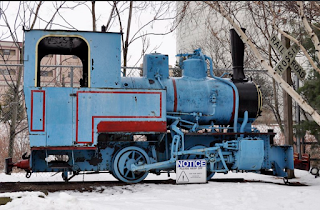LGB came to the Genesis type loco late...in their life. It wasn't until 2005 that LGB advertised the Genesis. While the similar ICE train was already an LGB fixture the AMTRAK Genesis was a new maneuver.
There was a test-drive in the mid 1990 with a toy-train set. First - in 1995- came the LGB # 90950, based on the ICE 2DB train. The LGB train was labeled LCE, probably for copyright reasons...
 |
LGB 90950 - courtesy of catawiki.com
|
 |
LGB 90950 in original packaging-
courtesy of Only Trains |
Then LGBoA and their customers wanted their own American version and right they were, since Amtrak had just started to invest in a new Diesel generation. And LGB realized the 'face-value similarity' of both bodies. Thus the AMTRAK version LGB 91950 was born and a bit later the LGB 92950. The LGB 90950 LCE was actually based on the German ICE train, a high-speed multiple unit train.
 |
ICE train in Frankfurt main station -
courtesy of en.wikipedia.com
|
At the same time the ICE was developed and manufactured the Americans were also looking for a modern Diesel engine. Where the German ICE 's main task was to transport passengers by train instead of by plane and thus be as fast as possible in a somewhat small country, the new Genesis had the aim to operate heavy long-distance trains with fewer locomotives and at lesser costs.
Its modernity and later success of the ICE train in Germany/Europe let the USA to inquire about the technology and after a series of tests the Germans didn't make it. The award (of contract) went to the French who ultimately provided all multiple units operating in the US as of today.
Amtrak wasn't looking for speed. Their main concern was to provide efficient transportation at justifiable costs for more and more freight volume across the US. A population growing by 30 million people every 10 years required infrastructure to be built, people to be fed, housed, clothed, educated and entertained with a need for freight alongside of that. The new Genesis generation provided just that, a modern Diesel-electric configuration with a light body engine with high horsepower and light housing.
 |
Amtrak P42DC - courtesy of en.wikipedia.com
|
Where long freight trains needed 3-5 and more locomotives the new Genesis generation required 2, 3 most for longer and heavier trains at even better speed (up to 100 mph). Time for the model-train'er to get one.......
LGB offered 5 engines over time. As mentioned above starting in 1995/96 with a toy-train model and going out in style with the LGB 22490:
Year LGB model #
1995/95 91950
1996 92950
2005 20490
2005/6 22490
2006 21490
The question is, why did the first LGB Amtrak toy train looked like an ICE train and why did it take LGB so long to offer the Genesis?
+++++++++++++++++++++++++++++ to be continued..................................
























